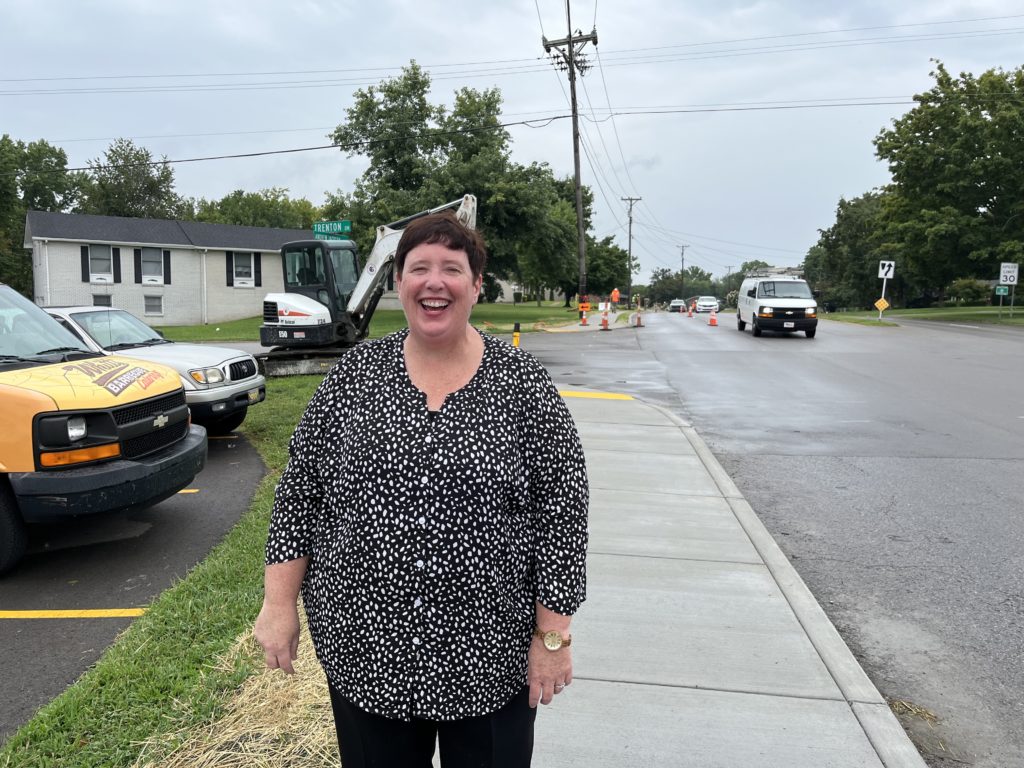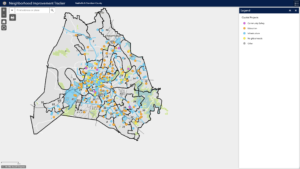
If you zoom in to the edge of District 12 on the city’s new neighborhood tracker, you’ll see a newly finished sidewalk that’s almost three-quarters of a mile.
It runs down Andrew Jackson Parkway, right in front of Whitt’s BBQ. If your back is to the restaurant, you can see residential homes to your left. On your right is Kroger, Starbucks and a bunch of other convenience stores.
“This is the first sidewalk project that District 12 has had in forever,” Councilmember Erin Evans says. “The last project was about a 5-foot section, and that was done probably five or six years ago.”
She says this sidewalk is crucial. It safely connects residents living along this busy street to the nearby stores. On the day WPLN News met Evans, a portion of the sidewalk was closed.
Nashville residents can now view how the city is spending money on physical projects in their district. The improvement tracker color codes development by categories — like infrastructure, community safety, education and neighborhoods.
The map shows some things most don’t notice, like culverts.
“Most people don’t think too deeply about culverts until they don’t work, but if they’re not properly maintained, it means severe flooding, pavement failure and road closures, which we were starting to see here,” Mayor John Cooper said in a press release.
 Courtesy Metro Nashville government
Courtesy Metro Nashville government Mayor John Cooper rolled out the tracker in Aug. 2022.
The neighborhood projects come from the city’s capital budget and spending plan, which is dedicated to large projects that last at least 10 years and cost more than $50,000.
The Capital Performance Manager in the Mayor’s Office of Performance Management is in charge of updating the map. It will be updated at least each quarter. Right now, it shows all active capital projects — some of which stretch back a few budget years.
In general, the Hermitage area is suburban and bumps right up to the Wilson County line. For some residents, it’s been their home for a while, but others are moving out there to get cheaper rents than what’s in the city’s core.
“I like the tracker,” Evans says. “It’s a very good start. I think we need more of this level of information for residents because the people that vote, they really want to know how their money is spent.”
Right now, residents can track each phase of a project from groundbreaking to completion. But Evans wants it to show more information, like when she asks for big projects for her district. She says only showing what’s gotten the green light can cause residents to share ideas that have already been pitched, and it doesn’t put into context the different needs in each district.
The mayor’s office says only items that have been funded will be shown.
Eventually, the mayor’s office will add filters so users can see specific kinds of projects, an equity lens and a dashboard to show the status and performance of Metro’s portfolio of capital investments.
The Metro Council approves the capital improvement budget and spending plan. In some cases, departments get a chance to prioritize the order things get done.

